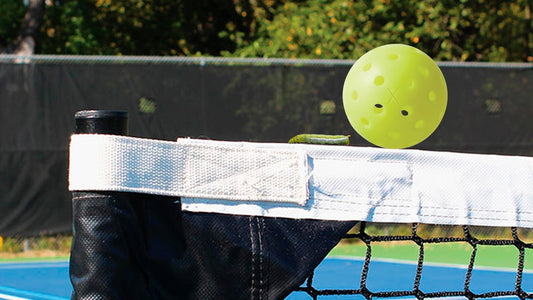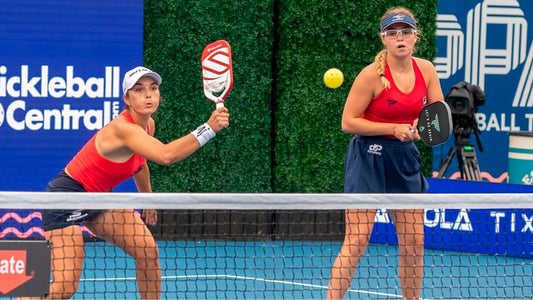
The 5 P’s of Pickleball: Power, Poaching, Paddle, Pivot, Pretend
Share
“Pickleball is chess at 100 miles per hour. It’s not just about what you hit. It’s why you hit it.” — Anonymous
Pickleball is a fast-growing, fast-paced sport that’s equal parts strategy, skill, and instinct. Whether you’re a seasoned player or just starting out, understanding the subtle—and not-so-subtle—tactics of play can give you a serious edge. That’s where the 5 P’s of Pickleball come in: Power, Poaching, Paddle, Pivot, and Pretend. Each one plays a critical role in elevating your performance and keeping your opponents on their toes.
Let’s break them down.
1. Power
Power in pickleball isn’t just about slamming the ball. It’s about knowing when to apply pressure. Well-timed drives, overheads, and speed-ups can disrupt your opponent’s rhythm and earn quick points. But raw power without control leads to unforced errors.
It’s also important to note that power doesn’t always come from muscle. It comes from technique. Using your core, legs, and paddle speed in harmony delivers more effective power than simply swinging hard. Power should be deliberate, not desperate.
Pro tip: Use power strategically by combining it with placement. Aim for your opponent’s feet or weak side to maximize effectiveness.
2. Poaching
Poaching is when you, or your partner, crosses over the centerline to intercept a ball meant for the other player. Done well, it can completely surprise your opponents and win the point. Done poorly, it leaves your side of the court exposed.
Poaching takes:
- Communication
- Trust between partners
- Timing
- Court awareness
A great poacher studies the rhythm of play and anticipates weak returns. The key isn’t just to move fast—but to move smart. It’s a calculated gamble that should be based on patterns, not impulse.
Pro tip: Poach only when you’re confident you’ll win the point, or when you’ve studied your opponents enough to know exactly what’s coming next.
3. Paddle
Your paddle is your most important tool, and knowing how to choose, hold, and use it makes all the difference. (Add more)
Key paddle considerations:
- Grip size and handle length affect comfort and control.
- Paddle weight and core thickness impact your power vs. finesse balance.
- Edgeless vs. edged paddles influence maneuverability and forgiveness.
Your paddle is an extension of your hand, so treat it that way. Keep your paddle up and in front of your body, ready to react. Players who drop their paddle or let it drift lose valuable time in fast exchanges.
Pro tip: Master your paddle angle and grip pressure. A loose grip softens the ball, while a firmer grip gives you better drives and volleys.
4. Pivot
Footwork in pickleball is everything. Being just one step late, or facing the wrong direction, can cost you the point. Pivoting allows you to maintain balance, recover quickly, and adjust your body to strike from the optimal position.
Don’t chase balls with your arm, move your feet. Pivots give you access to better court coverage, cleaner contact, and improved consistency. Good pivoting also reduces the risk of injury, especially during fast transitions or overhead recoveries.
Pro tip: Keep your knees slightly bent and stay on the balls of your feet. Pivot with purpose, and don’t get caught flat-footed in the transition zone plus carry your body weight on the leg that you are ready to push off from.
5. Pretend
Yes, pretend. Deception is a powerful weapon. Fake a dink and smash it. Look one way and hit another. Hesitate ever so slightly to throw off your opponent’s timing. These moments of misdirection can flip a rally in your favor. Also, note that your opponents are often watching your eyes to see where you will be hitting next. So, look ahead by hitting the ball to the side or look at their partner and dink the pickleball ball over the net.
Also, note that your opponents are often watching your eyes to see where you will be hitting next. So, look ahead by hitting the ball to the side or look at their partner and dink the pickleball ball over the net. Pretending isn’t cheating. It’s gamesmanship. It adds unpredictability to your game and forces your opponents to second-guess every move.
Pro tip: Mix up your shot selection. The more unpredictable you are, the harder you are to beat.
Game Point
The 5 P’s of Pickleball—Power, Poaching, Paddle, Pivot, and Pretend—represent a combination of physical skills, strategic moves, and psychological plays. Mastering them not only improves your game, but also makes you a smarter, more versatile player. Whether you're practicing at your local rec center or prepping for a tournament, keep these P’s in mind. They just might be the key to your next win.
See you on the courts!



